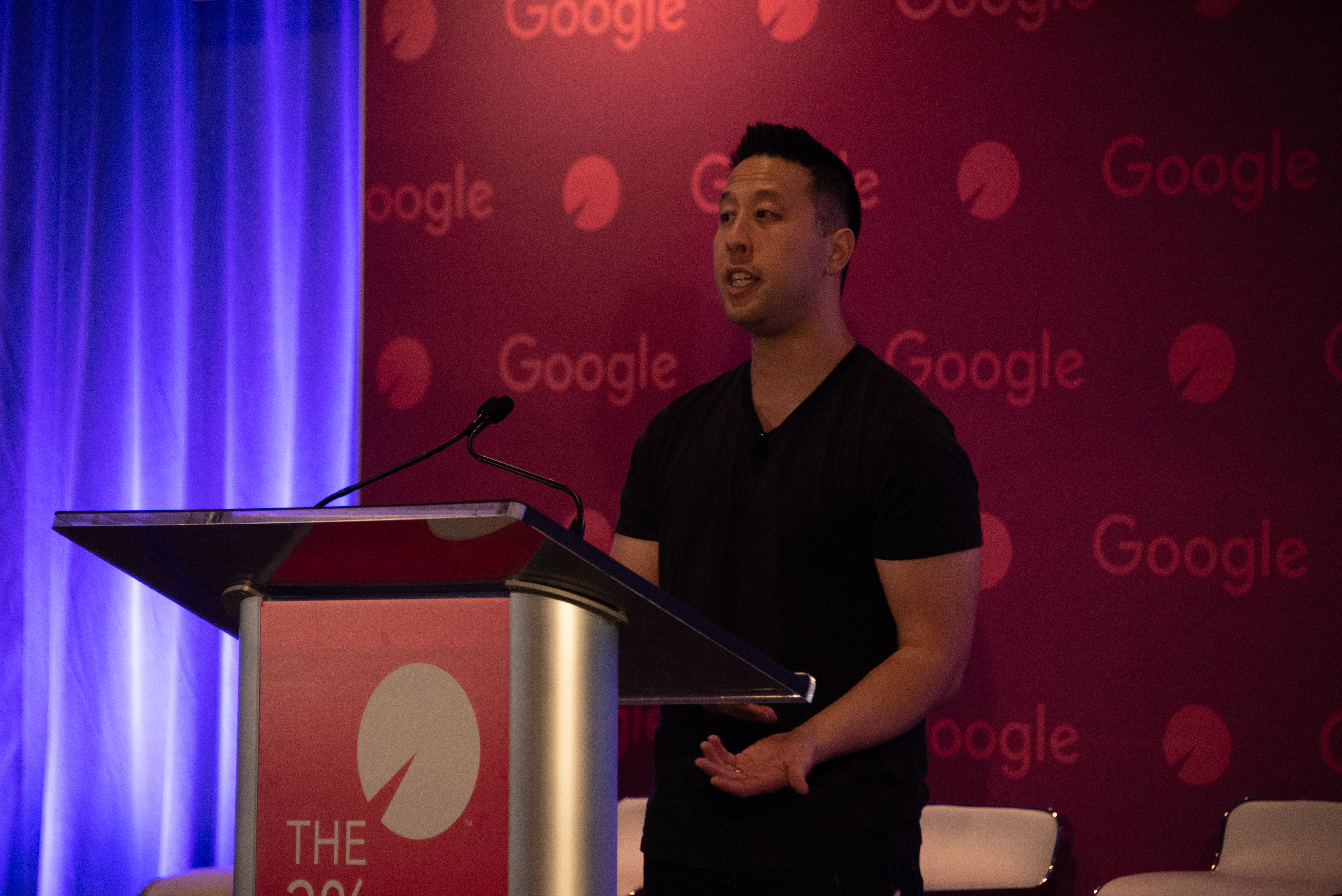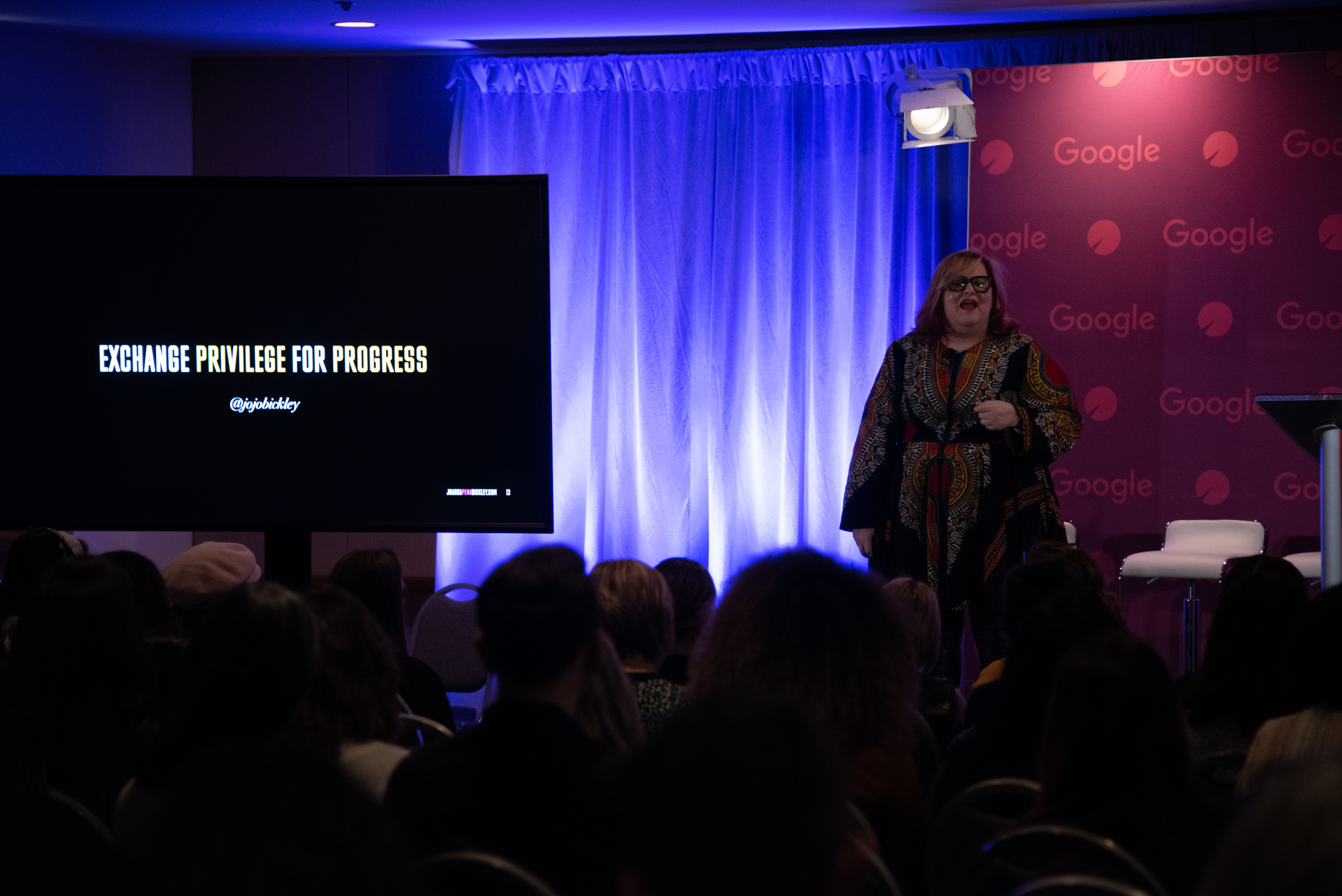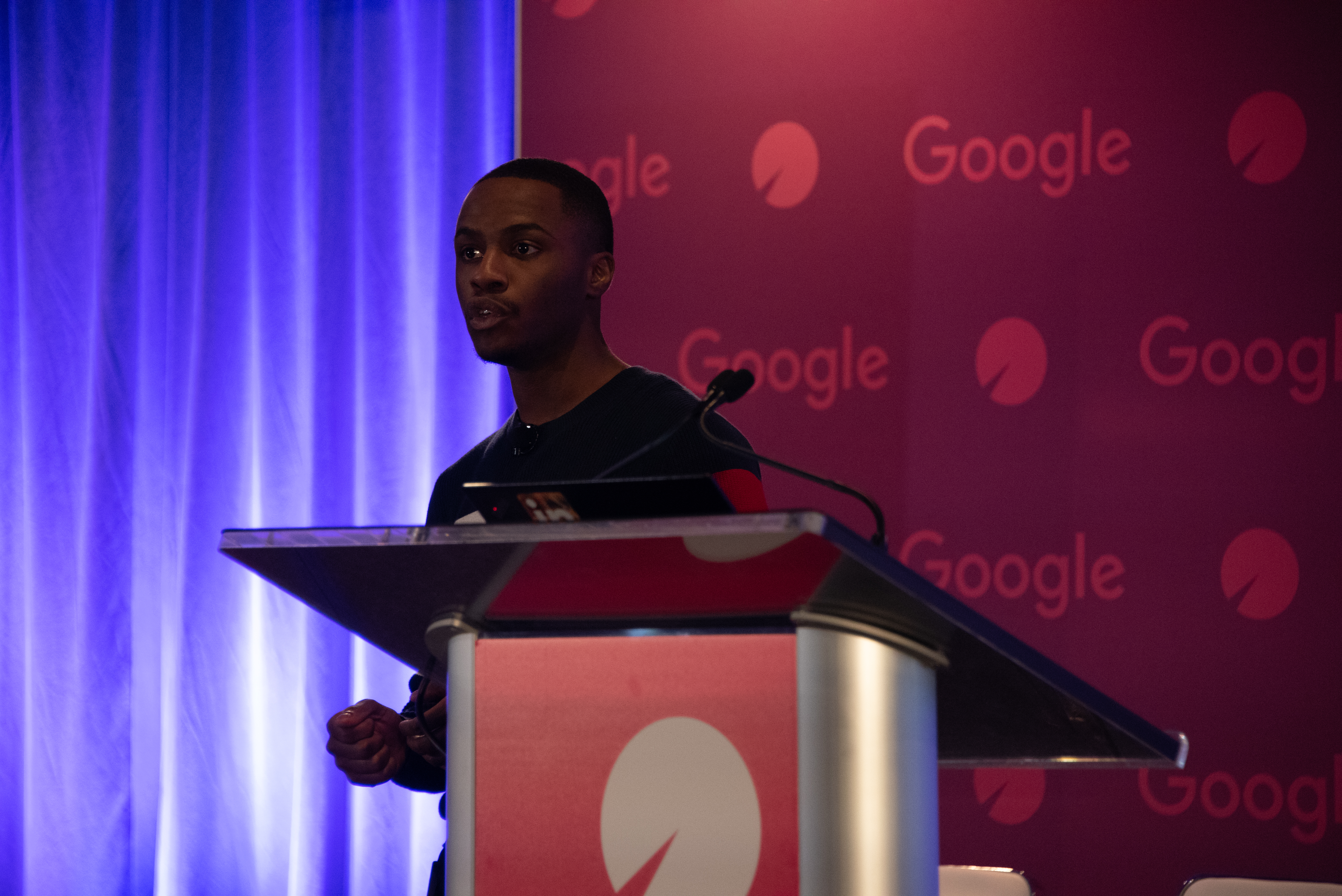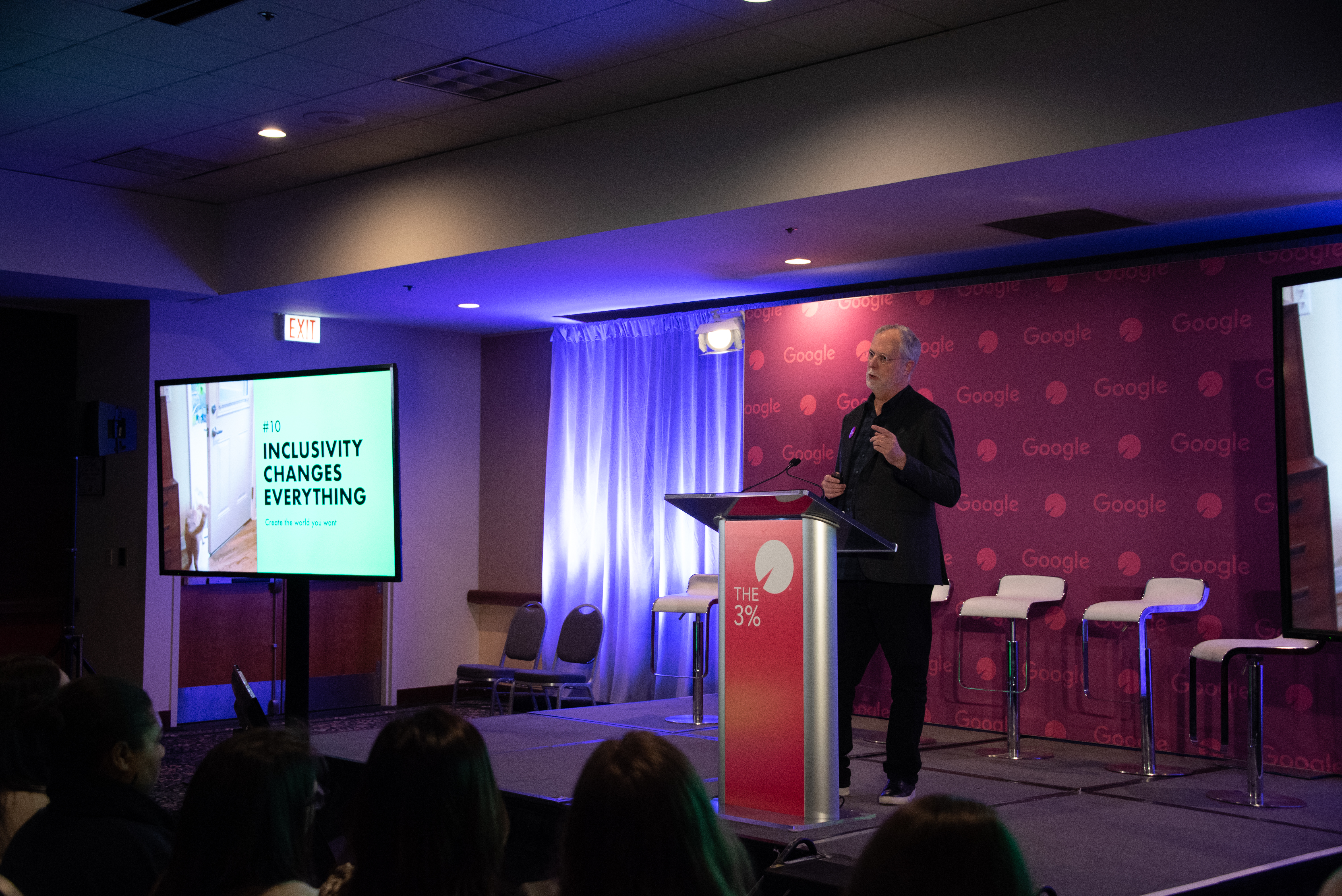
The 2019 Emerging Creative Track: Part 1
Kiku Gross is a writer, punk rocker, and general nuisance from the Central Valley of California. If she’s being totally honest, she’s made a name for herself in the advertising industry by yelling on the internet, and she’s kind of proud of it. You may recognize her from the 3% VOICES Blog, but you probably recognize her from Twitter. When she’s not busy writing words, she enjoys drinking coffee, listening to loud music, and taking naps.
As an emerging creative myself, being able to cover the Emerging Creatives Track was, dare I say, a perfect fit.
I’d be lying if I said I knew what to expect. And, truthfully, I’d be lying if I said I wasn’t a little skeptical. Look, as a conveniently, er, visual minority, I’ve been invited to more than a few of these “emerging creative” type talks. Though I’m still young in my career, I’ve all but stopped going to them because I’ve found these kinds of talks aren’t actually useful for me. But rather good PR for the people who are inviting me.
“Be yourself!” they say. “Be fearless!” they say. “Don’t take ‘no’ for an answer! Pull yourself up by your bootstraps!” they say.
Okay, Boomer. But what does that actually mean? And how am I supposed to implement any of that when I have: A) no power to advocate for myself and B) no capital to do something wild like start my own business? I mean, really. At this point in my life, I can’t even afford the bootstraps to pull myself up by.
But, this wasn’t your typical inspirational bullshit.
This was the 3% Conference. And here, people mean business.
Double-Sided: How Being Asian-American Made Me a Better Strategist
Speaker: Roger Chang, Senior Brand Strategist, Heat

“From a young age, every good Asian child is taught they can be anything they want when they grow up, as long as it's one of four career options: a doctor, an engineer, an accountant, or a disappointment to the family.”
Wow. Okay. That hit way too close to home. As someone who has also pursued the career path of “family disappointment,” I think that if I were to give a talk at the 3% Conference, it’d probably look (almost) identical to Roger’s.
Roger Chang’s speech was all about how living in two worlds (both the “Asian” world and the “American” world) has given him a unique perspective that’s made him excellent at his job as a strategist. And, of course, the way he touched on the importance of understanding culture, immersion, and empathy was great. Indeed, if we as advertisers want to connect to our audiences better, we need to understand our audiences for what they are—unique people—instead of sterile, academic concepts.
But to be perfectly honest, what stayed with me long after his speech was over wasn’t his actionables (which don’t get me wrong were cool), but his anecdotes.
As an Asian American person myself, I related to it all way too much. From being mocked at the grade school lunch table for my “weird food,” to silently shrinking away in meetings, to just being afraid to raise my hand, my voice, my profile, the stories Roger was telling could’ve very well been my own stories. And in those anecdotes, Roger made a parallel that I never would’ve come up with on my own: Advertising culture and Asian culture both prize harmony and conformity. And because of that, we’re only hiring people who won’t disturb that status quo.
I’ve touched on it before in blogs I’ve written for VOICES, but hearing it come out of someone else’s mouth was as sobering as it was gratifying. Truly, what’s the point of “diversity” if we want everyone to act the same, think the same, and come from the same schools and read from the same books? For as much as we sit around and bemoan the loss of the “original idea,” we sure do hire a lot of the same people. And it shows.
So what are we going to do about it? Well, I can’t tell you how to fix the industry (after all, I’m just a junior), but I will tell you what I’m going to do about it, by directly quoting from my favorite part of Roger’s talk:
“Don’t just shine for yourself — shine for others, too.”
(It’s the more professional version of Lizzo’s, “If I'm shinin', everybody gonna shine.”)
Truth be told, that might actually be my favorite moment from this year’s conference. Period.
I have always championed the value of loudly and unapologetically being yourself so that the next person has it just that much easier. I’ve benefited from it more than once in my life. As I’ve grown older, it’s become clearer to me just exactly what it means to be the first of “your kind” to try something.
And basically what I’ve learned is that it’s a lot easier if there’s someone whose footsteps you can follow.
Yes, I live at more than a few intersections. I’m a woman. I’m a person of color. I’m queer.
But, I’m also very lucky.
I get to be all of those things without much worry. I have a family that supports me, friends who love me, and a community both personally and professionally that I can rely on. I have a job, financial security, and most of all, privilege.
Because of that, it’s practically my duty to shine as brightly and to exist as loudly as I can. There are other people out there, who, for whatever reason, can’t live their fullest truth, and I have to be the beacon for them. Sure, that’s a touch self-important, but it’s true.
And yeah, it can be hard to be the most visible token sometimes, but it’s worth it. At least, to me, it is, and I hope it is to other people, too. I’d like to see what we can do when everyone is allowed to fully be themselves.
I’m willing to bet it’s going to be pretty cool.
An Unlikely Path to Invention and Lifelong Learning
Speaker: Joanna Pena-Bickley, Head of Research & Design, Alexa Devices at Amazon

Let’s get this out of the way right now.
Joanna Pena-Bickley is smarter than I am, or than I ever will be. She’s invented streaming services and makes the Amazon Alexa… you know… work. She sells companies to IBM. She makes stuff, and she makes stuff happen.
Me? Well, every now and then I tweet something that’s kind of funny, and even that’s barely at a 50% success rate.
So, as you can imagine, I was kind of confused as to why someone thought that I was the person who should cover this.
I mean yeah, my friends would argue that I also make things happen, but definitely not in the same way. I get things done through pure spite and resolve, not ingenuity. I’m the friend you want to play the classic pool game chicken fight with, because I’d rather drown than lose — not the friend that you take to an escape room.
In simpler terms: I’m an enforcer, not a mastermind. But as it turns out, there’s more to being a brilliant inventor than just brains. There’s a lot of tenacity involved, too.
The number one thing I took away from Joanna’s speech (aside from the fact that she is really, really smart) is the value of “what if?”
It’s very similar to my favorite question, “why not?”
Oh. I totally get why I was assigned this now.
As I’d quickly learn, Joanna and I actually have a lot in common. We’re both from tri-cultural families (Joanna comes from a Jewish-Mexican-American family and I come from a Japanese-Mexican-American family), our families are both matriarchal, and we both ended up in exceptionally unlikely situations for who we are because we just never stopped asking “what if?”
(Or you know, in my case, “why not?” but I digress).
In a way, it was the perfect companion to Roger’s talk. Where Roger’s talk asked you to clear the path for the next group of people and asked you how you will help them, Joanna’s talk asked you to look back, and ask yourself: what have people sacrificed to get you where you are today? And how will you honor that?
In a way, it was the perfect companion to Roger’s talk. Where Roger’s talk asked you to clear the path for the next group of people and asked you how you will help them, Joanna’s talk asked you to look back, and ask yourself: what have people sacrificed to get you where you are today? And how will you honor that?
To quote Joanna’s grandmother, “You will get to sit at tables we were never able to. So what will you do?”
See, when you’re constantly reminded of how much people have given up to get you where you are, it is absolutely tempting to “play it safe,” to not make waves, and to not ask feather-ruffling questions like “what if” or “why not.” But it’s not truly honoring those who have sacrificed for you.
What I learned from Joanna is that the best way to honor people who have sacrificed for you is to take a risk, and sacrifice for someone else. To continue to ask “what if?” and to make spaces for people who needed an opportunity, just like you did.
"The only truly risky thing out there is to play it safe..."
To make a long recap slightly less long, the biggest takeaway from Joanna’s talk for me was the idea that the only truly risky thing out there is to play it safe, and to not make a change.
Now, to be fair, that’s not a new thing, or even a new concept to me. But I’m so used to white dudes in hoodies saying shit like that to me, that hearing a woman of color (who actually understands what it means to take a risk when people have sacrificed so much for you) say it was refreshing. And it was inspiring, too.
What will I do?
(Oh, and one last thing: Joanna totally debuted her new project, Designed By Us, at the end of her talk. Designed By Us is a “non-for-profit on a mission to reimagine design education with a S.T.E.A.M.D. (Science, Technology, Engineering, Arts, Math, and Design) curriculum at the nascent stages of a new industrial revolution .” I highly recommend you check them out at https://designedbyus.org/)
Lunch and Learn: Rock Your Profile: Your Brand, Your Story
Speaker: Johnathan Hill, Media Solutions Manager, Talent Solutions, LinkedIn

Vivacious.
It’s a word I hate, actually. Usually because it’s applied to me and usually because when it is applied to me, it’s very creepy.
But I don’t have another word to describe Johnathan Hill, and I hope he’ll take it as the compliment I mean it as. The way he managed the room was more than impressive. He was lively, engaging, and yes, vivacious. I liked him quite a bit, even if I didn’t get a free LinkedIn Premium membership.
Doing the lunchtime presentation is hard. People are filtering in, trying to balance their strange little catered boxed salads on their knees between thick programs and Google Home Minis, and also trying not to spill their canned sodas.
People are in the room, sure. But whether or not they’re mentally present is a whole other story.
I was trying my best to pay attention between bites of salad. After all, learning how to optimize my LinkedIn profile so I could get a job was a very appealing topic. And yes, every college in the world has run this seminar, but not with a real live LinkedIn employee!
Disappointingly, he did not teach me how to hack any algorithms. But much like any other form of optimization, visibility isn’t actually about hacking profiles. It’s about good content.
Mostly, what Johnathan spoke about was personal branding.
He covered the basics that in this social media age we’re all aware of, like “How do people perceive you?” But, he also covered more LinkedIn-specific attributes, such as “How am I showing up in searches,” “What conversations are people having about me,” and of course, “What do I have to offer?”
So, then. If it’s all about good content and personal branding, what makes a good LinkedIn Profile?
- You need to figure out what your top five brand attributes are, and figure out if they’re coming through in your profile.
- You need to leverage your LinkedIn profile to assure that your brand is coming through, especially to employers.
- You actually have to use LinkedIn. It’s not enough to just have a page.
- Part of using LinkedIn is actually creating and publishing content, not just responding to content or sharing it. (The point here is to be a thought leader, not a thought regurgitator.)
- And finally, you need to do steps one through four consistently and frequently. After all, building and maintaining a brand is work.
Admittedly, I don’t have a deep, thoughtful connection to make to this talk, but I suppose not everything at 3% needs to be inspirational quotes and tears. Sometimes things can just be useful, and that's okay, too.
Plus, this did inspire me to update my LinkedIn immediately after, and several weeks after this talk, I’m happy to report that Johnathan’s tips did actually work.
It’s almost like he works there. Weird.
Beyond Work/Life Balance: Work/Life Blending
Speaker: Joe Crump, CEO, Wunderman Thompson

Ok, real talk. Why am I always the junior that ends up covering a RIWM (Really Important White Man)? Is it because I’m young? Is it because I don’t know any better and will speak my mind? Is it because people figure I still have enough time left in my career that if I do say something career-ending, I still have enough time to fix it?
Sorry. I’m getting off track. The point is, I was definitely nervous when I got this assignment.
What was I going to say? What if I didn’t like it? God, more than that, what the hell was my insight going to add to a speech given by someone who’s had a career longer than I’ve been alive? Joe Crump has won Lions. Joe Crump lead a 3% Certified agency. Joe Crump was an Executive Creative Director, and now he’s a CEO.
Honestly, what could I possibly have in common with an older white man who is the CEO of a gigantic advertising agency?
And then Joe Crump brought out the cat gifs. Because Joe Crump loves cats. And his talk would use his side-project, the Koneko Cat Cafe, as an example throughout.
Aw.
It’s not a wild, unfathomable thing, but I’m so used to toxic, aggressive masculinity in the workplace that a man showing love for anything, especially small, fluffy cats (and how he wanted to help them get adopted) had me taken aback.
I mean, if I’m being really honest, there are weeks I’m afraid to take a lunch break, let alone a week of vacation. Have I really earned the right to 30 minutes to eat food? I can, after all, eat while working.
But Joe Crump wasn’t as out of touch as his C-suite title suggested. Rather, he knew that this whole “work/life balance” thing doesn’t exist. Especially not for people like us. You know. Creatives.
Our job doesn’t stop when we clock out. Not just because advertising is often a grueling, all-consuming thing. But, because a creative brain is like a precocious toddler. It just doesn’t shut up. It’s constantly asking questions and making up scenarios and those scenarios aren’t always whimsical Coke ads, okay? It’s no wonder that creatives are also exceptionally neurotic and often unpleasant — you would be too if your brain never shuts up.
So instead, Joe walked us through what he called “work-life blending.”
Okay. I’m listening.
Effectively, what Joe wanted for us young people was to find joy in our lives. Not just in our life outside of work, but in our work, too, and that’s how we were going to have long, fulfilling careers.
He wanted us to, quote, “never compromise” when it came to finding joy, and when it came to having a positive outlook. He implored us to stay “laser-focused” on the things that we love, and then to be sure that we were doing them with the people we love.
“Everything else,” he said, “sorts itself out. I promise you.”
Of course, that’s the easy and fluffy stuff. But one doesn’t get to be CEO with just kitten whiskers and happy feelings alone. What really stood out to me about Joe’s speech is that it would’ve been easy to stay on the happy-go-lucky track. To tell us kids to just look on the bright side of life. To ignore bad feelings and focus on positive vibes only.
But he didn’t.
The second half of his talk was a rallying cry for us in a way that I thought was brave. Especially since I got the feeling that he genuinely meant it.
While he wanted us to “never compromise” on finding joy, he also wanted to make sure that we “never compromised” on our morals and values either. He swore that our morals and values do have a place at work. Yes, he wanted us to enjoy our lives and our work, but he also wanted us to be agents of change.
“If our industry is going to get better,” he said, “it’s going to get better because of you. And if joy is at the heart of that? Then it’s going to be a better world. Not just a better industry.”
Truly, it struck me, not only that Joe had so much faith in us, but that he seemed to appreciate our heart, too. Not to start a generation war or anything, but these days it seems like the older generations are writing us off more and more, and that part of the reason why they’re writing us off is because we’re “too sensitive” or “too soft.”
Yet, here was the CEO of one of the largest ad agencies in the world telling us not only to seek fulfillment and joy but also who championed inclusivity and empathy. Openly, he admitted that his generation had “kind of fucked it up,” and that he was looking forward to us taking over.
I had genuinely never heard that before.
Ultimately, I realized the key to work-life blending was to just be a person you weren’t ashamed of being. Sure, us creatives will never have the perfect work/life balance, but that’s okay as long as we stay committed to doing good work and doing good in the world.
As with every other talk that I covered on this track, to do so certainly wouldn’t be easy. But it would be worth it. After all, it worked out alright for Joe. And if never compromising on my joy or my morals means that I’ll get to be a CEO some day?
Well, that would just be a bonus. But I’d settle for owning a cat cafe, too.




